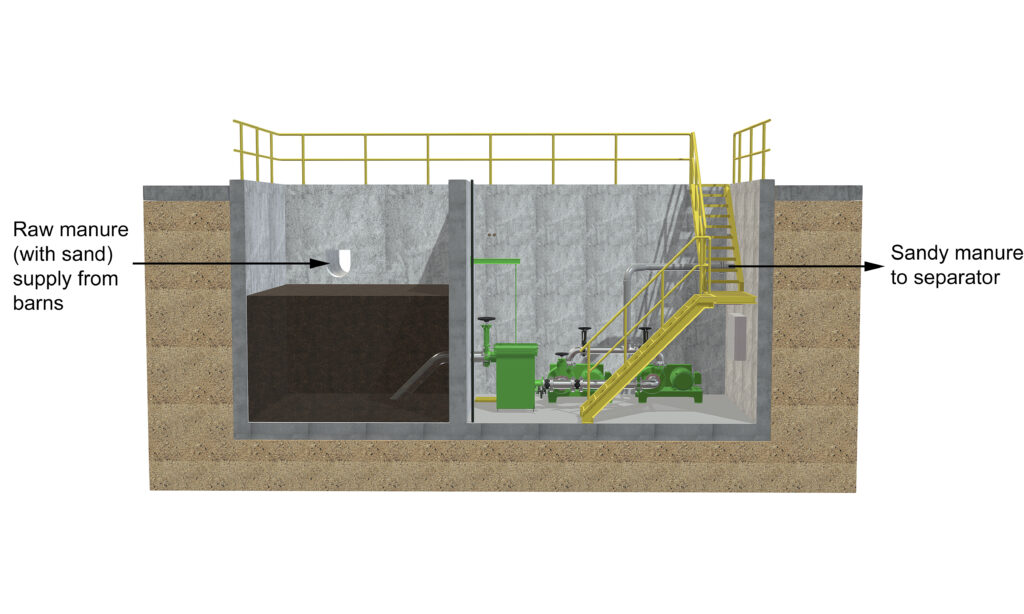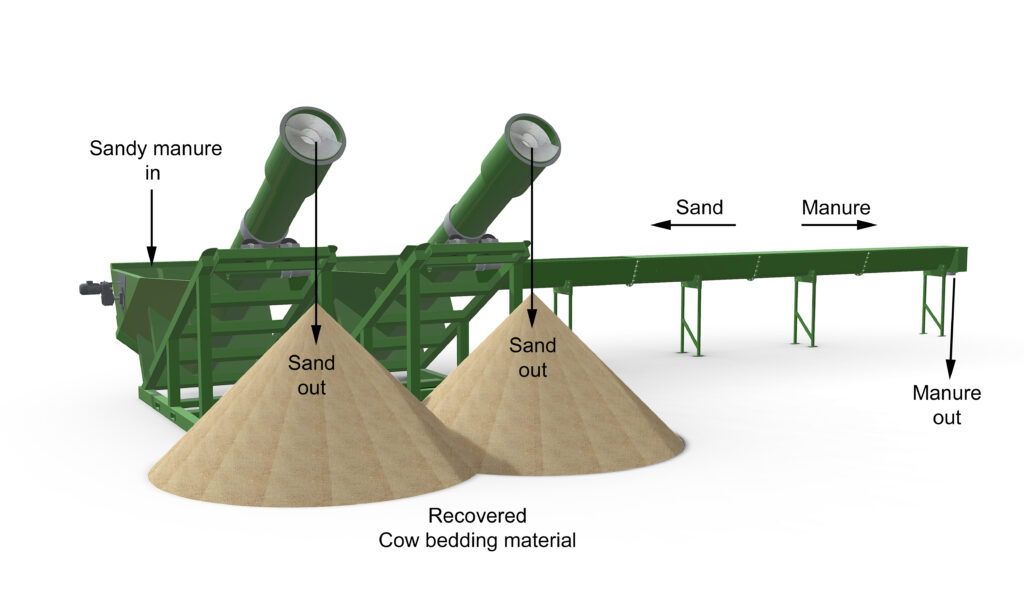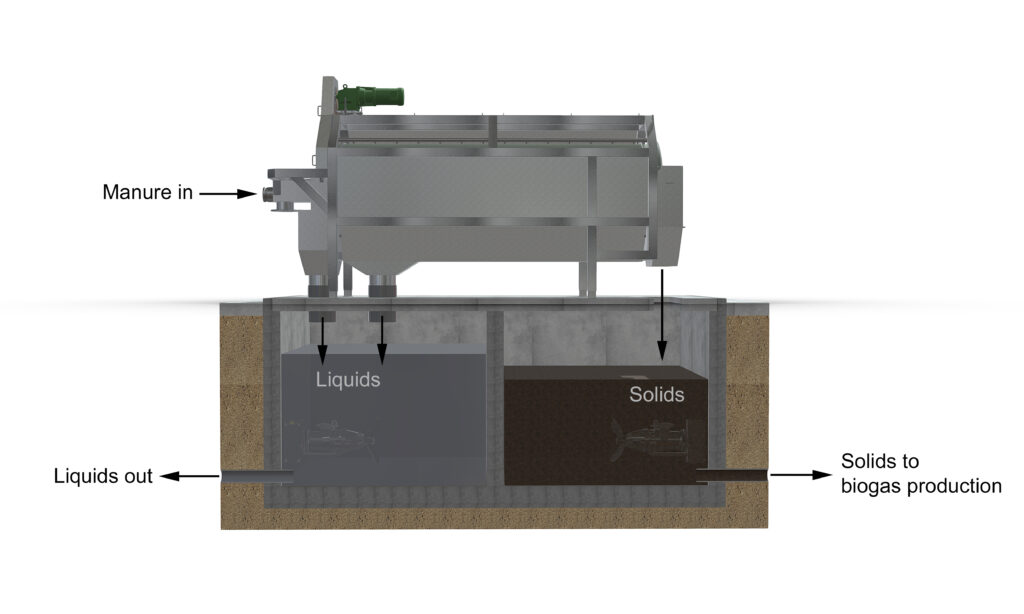The integration of 3D models into online articles has revolutionized the way we present information.
Readers can now engage with the content on a whole new level, improving their understanding and retention of the material. Visitors will visit the website longer and interact, resulting in a positive experience. And positive visitors are more likely to see you as an expert, from whom they would like to receive advice or products.
For example, imagine an article about reusing sand for cow bedding – instead of static images, readers can interact with 3D models of the equipment needed to do this, really visualizing the concept.
Example article:
Sand bedding for cows

Why sand as cow bedding material
The use of sand as cow bedding has gained popularity in the dairy industry in recent years. This practice offers numerous benefits for both the cows and the farmers.
Firstly, sand offers excellent comfort for the cows. The soft, resilient surface of sand allows cows to lie down, rest and chew their cud comfortably. This contributes to the well-being of the animals and can increase milk production.
Another advantage is hygiene. Not only is sand easy to keep clean, but it also prevents the growth of bacteria and mold, which often cause problems with more traditional bedding materials such as straw or sawdust. This results in cleaner stables and healthier cows.
In addition, sand is sustainable and reusable. Unlike materials such as straw, which require regular replacement, sand can last for years with proper care. This saves farmers money and reduces environmental impact.
Sand facilitates manure management. It absorbs urine efficiently, minimizes odor and simplifies manure removal. This makes cleaning and maintenance of the stable much easier.
Reuse of sand
It is essential to recover the sand that ends up in the manure pit for reuse for several reasons.
Firstly, recovering the sand ensures a more sustainable and cost-effective dairy farming operation. This saves farmers money because they have to purchase less new sand.
In addition, reusing sand contributes to environmental protection. It prevents large amounts of sand from accumulating in the manure cellars, which can complicate manure processing and increase the risk of environmental problems such as soil contamination.
In addition, reclaiming sand can make manure pits more efficient. A clean manure cellar provides more storage space for manure, which can help manage manure surpluses and comply with environmental regulations.
Reusing sand from the manure pit is a win-win situation for farmers and the environment. It reduces costs, improves manure processing and contributes to sustainability and circularity in dairy farming.
Sand & Manure Handling in 3 steps
Step 1: Collect the sandy manure in a raw manure/pump pit

The raw manure- and pump pit
The first step required is to collect the sandy cow manure in a “raw manure pit”. The manure is usually supplied from the stable via a manure channel that leads to the pit with a slope.
From this manure pit, the sandy manure is pumped to the manure-sand separator, often with a pump that is placed in its own pit at the same level as the bottom of the manure pit.
Both manure processing pits can be fitted with a roof.
Step 2: Sand separation from the sandy manure

The Daritech (double) Sand Cannon
Daritech and Mavasol‘s Sand Cannon system uses a combination of mechanical processes to separate sand from the liquid manure. The process begins by mixing manure and water to create a slurry. This slurry is then passed through a rotating cylinder, where the heavy sand particles sink to the bottom and are separated from the lighter liquid.
After this separation, the recovered sand can be cleaned and dried for reuse as bedding material. This saves farmers money and minimizes sand waste. Furthermore, it contributes to cleaner and more efficient manure processing, which is essential for environmentally friendly and sustainable agricultural practices.
The Daritech Sand Cannon system is an example of advanced technologies being deployed to improve efficiency and sustainability in the agricultural sector, particularly in relation to manure processing and reuse of valuable materials such as sand.
Step 3: Manure separation solid – liquid

The Daritech DT360 Manure Separator
The DT360 system works based on mechanical separation technology. It starts with introducing the manure into the system, where it is mixed into a homogeneous suspension. This suspension is then guided through a rotating drum or cylinder, which is provided with openings of different sizes.
This allows the liquid components to flow through the openings, while the solid particles such as sand, manure balls and organic materials are separated and discharged to the outside.
How are these interactive 3D models made?
To start, you need to understand that there is a difference between a 3D CAD model and a 3D Render model.
A 3D CAD model is all about precision, materials and especially the technical drawings that can be extracted from the 3D model. With a 3D render model, the colors, shadows and appearance are important.
The software to create these 2 different types of 3D models is also very different, as are their file types.
So the trick is to turn a 3D CAD model into a 3D Render model. And after a long search for the best way to do that, I finally found a way that converts all the details of the original 3D CAD model.
In short it comes to this:
- Design the product in your native 3D CAD modeling software (e.g. Inventor or Solidworks).
- Convert the 3D CAD file to a 3D step (.stp) file format.
- Upload the step file into Autodesk Fusion 360
- Edit the colors and materials in Autodesk Fusion 360.
- Then convert the Autodesk Fusion 360 (.f3d) file to an .fbx file.
- Upload the .fbx file into Sketchfab, from now on it is a 3D render model instead of a 3D CAD model.
- Fine-tune the colors and materials with the Sketchfab tools.
- Set the starting position of the 3D animation.
- Save the 3D model as a .gitf file.
- Copy the code and place it in your WordPress website.